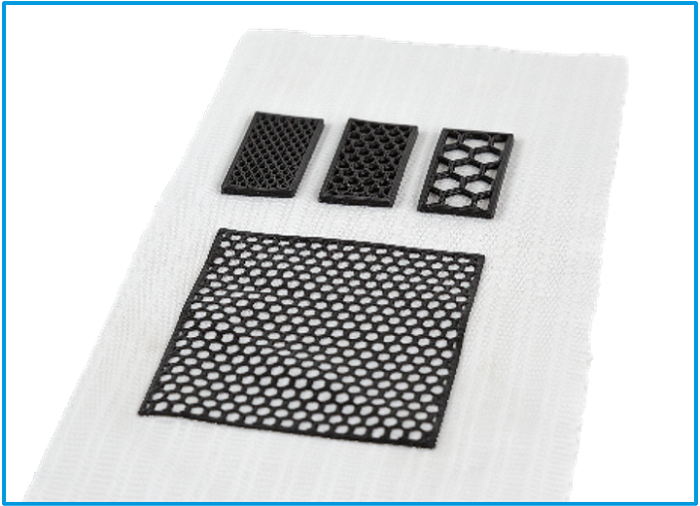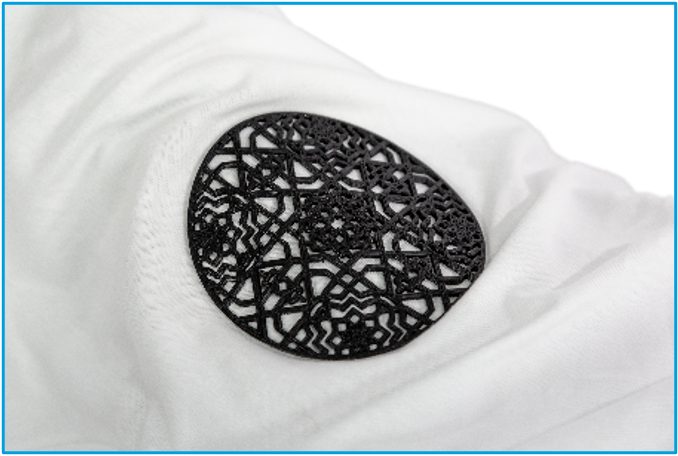German company ViscoTec develops systems needed for conveying, dosing, applying, filling, and emptying fluids, which includes printheads for viscous fluids and two-component 3D printing. Its innovations are used in many industries, from aerospace, e-mobility, and food to medical and pharmaceutical, and now textiles as well. French company Lynxter, which manufactures modular industrial machine tools and 3D printers, is using ViscoTec’s printheads for an interesting textile 3D printing project.
While 3D printing has been used before with textiles, the thermoplastics typically used in this application don’t have the elasticity, flexibility, texture, and wear resistance needed when you’re working with fabric. Lynxter sees 3D printing as a true production tool, and decided to take a closer look at how silicone 3D printing material behaves with textiles, since its modular S600D 3D printer can work with the soft, elastic material.
Silicone is a polymer with great chemical and UV ray resistance, which makes it good for fabricating medical prosthetics. But, the material also adheres well to fabric, a quality Lynxter is putting to good use in optimizing technical functions of textiles for its luxury goods and sportswear clients.
“3D printing of silicone makes it possible to meet the growing demand for product customization from consumers looking for uniqueness,” Lynxter wrote in an interview with ViscoTec. “This solution also gives the freedom to create patterns with complex 3-dimensional shapes or different layer heights, which are impossible to achieve with traditional processes. It offers greater possibilities for designing custom-made patterns, as well as a wide choice of positioning patterns on the fabric which were not always accessible with other processes. The user will be able to work more creatively, and the silicone’s characteristics ensure the expected comfort of a garment.”
Lynxter needed a compact printhead with limited mass and the ability to embed electrical components with standard AM control boards. It also had to be able to handle different compatible flow rates and viscosities. The tool head on Lynxter’s S600D printer can be easily changed in order to print different materials, which is why the company chose ViscoTec’s vipro-HEAD 3 for silicone printing, after testing it with several kinds of fabric, like polyesters and cottons, as well as standard and custom silicones, with multiple extrusion speeds, string width, and thicknesses. Lynxter also explained that the company’s accurate, reliable, and quality components made the choice a no-brainer.
The company selected a one-component RTV silicone, with a shore hardness of 34, to 3D print on the textile, as the “characteristics meet the constraints of use and maintenance of textiles: elasticity (high elongation rate), heat resistance, and resistance to moisture and chemicals.”
“Once the printing project has been defined, the machine deposits silicone beads on the fabric to create a 3D pattern. Printing and drying times will vary depending on the size and complexity of the project,” Lynxter wrote.
“We quickly and precisely create a 3-dimensional pattern on the fabric. The printing integrates perfectly with the type of textile, e.g. comfort, fluidity, elasticity. This ensures that the garment is pleasant to wear after the process. The aesthetic result is highly satisfactory. Following the various wear tests carried out, the silicone held well on the fabric when in use and showed good stability during washing.”
Lynxter says that 3D printing silicone on textiles can be considered “a real asset for companies,” as items can be fabricated in the actual area where products are made, which negates the use of go-between companies and shipping—creating a lower carbon footprint in the process. An additional benefit is an economic one, as this can lower “the margins linked to intermediaries and constitutes a gain in reaction time and efficiency for companies.”
Textiles with 3D printed silicone can be used in many applications requiring personalized and branded fabrics, such as furniture, fashion, sporting equipment, and others.
“Interesting projects will be further developed and implemented in the coming months,” Lynxter wrote. “We are still only just discovering the potential of this technology, but the feedback from the field is already very positive.”
(Images courtesy of ViscoTec unless otherwise noted)
Subscribe to Our Email Newsletter
Stay up-to-date on all the latest news from the 3D printing industry and receive information and offers from third party vendors.
Print Services
Upload your 3D Models and get them printed quickly and efficiently.
You May Also Like
Consolidation in AM: How 2025 Is Shaping the Industry’s New Normal
The first half of 2025 has been marked by a clear shift in the additive manufacturing (AM) industry. Companies are no longer just focused on developing new tech by themselves....
Etsy Design Rule Change Reduces Selection of 3D Printed Goods
Online marketplace Etsy has implemented a rule change requiring all 3D printed goods on the site to be original designs. The update to the site’s Creativity Standards states, ¨Items produced using...
U.S. Congress Calls Out 3D Printing in Proposal for Commercial Reserve Manufacturing Network
Last week, the U.S. House of Representatives’ Appropriations Committee moved the FY 2026 defense bill forward to the House floor. Included in the legislation is a $131 million proposal for...
Transforming From Tourist to Native: Duro CEO Michael Corr Explains Why the Company Rebuilt its PLM Software on AI
In these early innings of the AI boom, many market analysts have expressed concern that AI spend has gotten too far ahead of the technology’s proven ability to deliver significant...





































